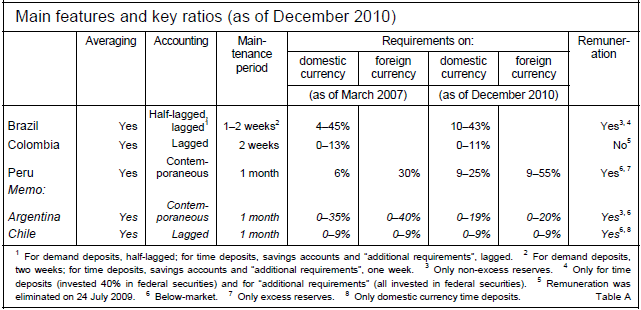Operating procedures for reserve requirements
(Extract from page 56 of BIS Quarterly Review, March 2011)
Reserve requirements can have different effects on the banking system, depending on how they are structured. Table A presents the main features of reserve requirements for the three Latin American countries discussed in this paper and (for reference) Argentina and Chile. Mexico does not impose reserve requirements.1
All three countries fulfil their reserve requirements on an average basis (column 1) during the maintenance period (the period for which the corresponding required reserves must be held; see Borio (1997, p 47)). The maintenance period ranges from one week to one month (column 4). Brazil and Colombia have lagged reserve accounting frameworks, while Peru maintains a contemporaneous system. In lagged systems, the calculation period precedes the maintenance period. In semi- or half-lagged systems these periods partly overlap, and in contemporaneous frameworks the ends of both periods coincide. The advantage of lagged reserve accounting is that the amount of required reserves is known with certainty, whereas in contemporaneous frameworks data collection lags create an incentive for banks to over-provision in order to meet reserve requirements.
Required reserves tend to be lower today than in early 2007, reflecting sharp reductions in response to the crisis. Also, they vary greatly across countries, ranging from as low as zero (in Colombia, for certificates of deposit with maturity longer than 18 months) to 43% (in Brazil, for demand deposits).2 In many cases, reserve requirements are remunerated at below-market rates, which partly reduce their distortionary tax effect but also lessen the impact of changes in the reserve requirement rate on the banking system. It also means that the central bank assumes some cost when raising reserve requirements. Colombia does not remunerate reserves from July 2009, Brazil remunerates only required reserves, and Peru remunerates excess reserves.
Certain other characteristics can also influence the effectiveness of reserve requirements as a policy instrument. For example, changes in reserve requirements will have a smaller impact if the amount of deposits subject to reserve requirements relative to domestic bank credit is small. In Brazil, Colombia and Peru, these ratios were, respectively, 0.6, 1.1 and 1.1 in October 2010. Also, the impact will vary over time if the changes are made through the level or through the marginal reserve requirement. When the reserve requirement level is changed, the effect is almost immediate. In contrast, a change in the marginal reserve requirement has a small effect at the beginning that increases over time. As shown in Graph 3 in the main text, Colombia and Peru adjusted both marginal and average reserve requirements, while Brazil only adjusted average reserve requirements.
1 Ho (2008, Table 2) describes the main features of reserve requirements in a sample of Asian and other economies.
2 Peru also has reserve requirements in foreign currency, although these are outside the scope of this article. In Peru, a dollarised economy where around 50% of credit is in US dollars, reserve requirements in foreign currency are set at a high level to reduce the risks of sudden reversals in the flows of foreign currency deposits or foreign credit lines (Quizpe and Rossini (2010)).

